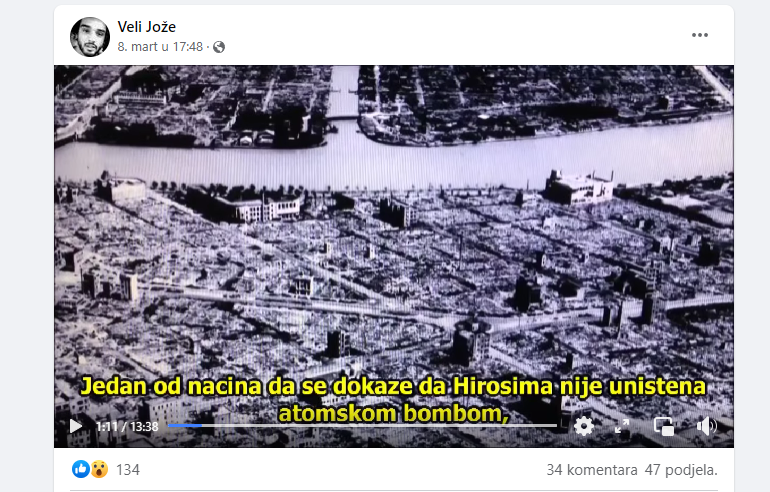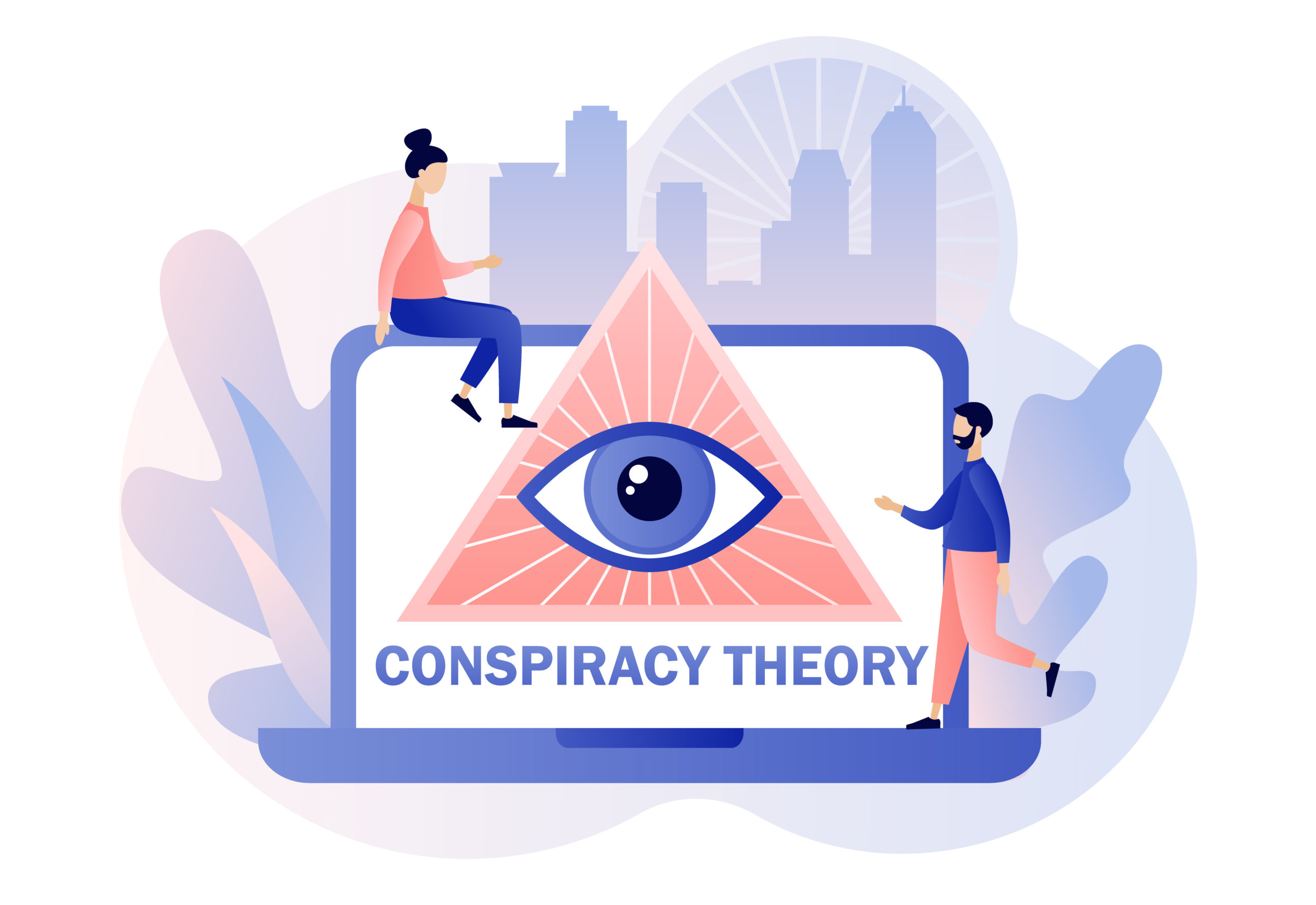Original article (in Bosnian) was published on 18/03/2022
When the war in Ukraine started, the old conspiracy theory that nuclear weapon is a lie designed to intimidate the masses became popular on social media. Unfortunately, nuclear weapon is a real threat.
Since the beginning of the war in Ukraine, the danger of an international nuclear confrontation has been increasingly talked about in public in the context of Russia’s arsenal. On the other hand, conspiracy theorists have popularized their “version” of the world on social media, in which nuclear weapons do not exist.
Dozens of Facebook profiles and pages contain posts claiming that nuclear weapon is a lie and that the atomic bomb attacks on Hiroshima and Nagasaki did not happen (1, 2, 3, 4, 5).
An article containing these inaccurate claims was published in 2012 on the “conspiracy” website Transformacija svijesti, and the source used in it was the foreign forum Nuke Lies (Lies about nuclear bombs).
In recent days, the posts on the Facebook profile of Veli Joze (1, 2, 3) have been especially noticed, which have been shared almost a hundred times till writing this analysis.
Veli Joze claims that nuclear weapon is actually a myth for intimidating the masses and that it does not exist. This profile “corroborates” such claims with videos claiming that the dropping of the atomic bomb on Hiroshima and Nagasaki was falsified and studies claiming that the descendants of the survivors from these two cities did not develop congenital abnormalities.
What is a nuclear weapon?
A nuclear weapon is a device designed to release energy in an explosive manner, as a result of nuclear fission, nuclear fusion, or a combination of the two. Physical weapons are usually called atomic bombs, and fusion weapons are called thermonuclear or hydrogen bombs.
According to a 2020 article published on the website History, scientists have developed technology to produce nuclear weapons in World War II. The development of this technology was made possible after scientists Otto Hahn, Lise Meitner and Fritz Strassmann discovered the process of nuclear fission in Germany in 1938.
They found that when an atom of radioactive material splits into lighter atoms, there is a sudden, strong release of energy. Nuclear fusion is a process in which two lighter atoms merge and release energy.
In 1942, US President Franklin D. Roosevelt approved the Manhattan Project, which aimed to develop a functional atomic bomb. As part of this project, the first atomic test bomb was successfully detonated in July 1945 in the desert in the US state of New Mexico. Less than a month later, the United States dropped atomic bombs on the Japanese cities of Hiroshima and Nagasaki.
According to an article in the Encyclopaedia Britannica, many countries have since developed much more powerful nuclear weapon with the potential to cause even greater destruction.
Concerns over the catastrophic consequences of detonating such weapons in a potential conflict have prompted state governments to negotiate arms control agreements, such as the 1963 Nuclear-Test-Ban Treaty and the 1968 Non-Proliferation Treaty.
There are currently nine countries in the world with nuclear weapons: the United States, Russia, China, France, the United Kingdom, Pakistan, Israel, India and North Korea.
Despite the claims of “conspirators” from social networks, nuclear weapons exist. The inventions that enabled the production of such weapons and their activities have been clearly documented in the past decades.
What happened in Japan in 1945?
On August 6, 1945, the US army dropped an atomic bomb on the Japanese city of Hiroshima. Two-thirds of the city was destroyed, and over 70,000 people died immediately, according to Britannica. Three days later, on August 9, another bomb was dropped on the city of Nagasaki. According to Britannica, this city was a difficult target due to its geographical position. However, the atomic bomb caused enormous damage, completely destroying 40 percent of the city and killing 40,000 people. Due to radiation poisoning after the bombing, the number of deaths in Hiroshima rose to over 100,000 by the end of the year, and to over 70,000 in Nagasaki.
After the bombing of Nagasaki, Japan capitulated, which ended World War II.
On March 8, 2022, Veli Joze published a video in English, with a translation into our language, claiming that these two cities were bombed with napalm bombs and that nuclear weapons do not actually exist.
Photographs of Hiroshima after the bombing were presented as “evidence” for these claims, after which the author of the video claimed that the destroyed city looked too much like Tokyo after the napalm bombing, and concluded that an atomic bomb did not hit Hiroshima.

It is clear that his conclusion is meaningless and that the fact that several buildings were not completely devastated is not proof that the atomic bomb was not dropped.
The narrator of the video is not convinced that an atomic bomb was dropped on Hiroshima, despite the fact that there is a recording of that event, which he claims to be forged without any concrete evidence.
Thus, claims that Hiroshima and Nagasaki were not destroyed by atomic bombs are unfounded. These attacks, as well as their horrific consequences, have been documented in detail.
In another post from March 8, Veli Joze published a link to a study that, according to him, proves that radiation exposure in Hiroshima and Nagasaki did not cause genetic damage.
A 1990 study compared over 30,000 children whose parents survived the atomic bombing and over 40,000 children whose parents were not exposed to radiation. The study concluded that no significant difference was found in congenital abnormalities, childhood cancer and abnormal chromosomes, according to an article published by the Washington Post that year.
On the other hand, the scientists emphasized that they cannot assume that there is no genetic damage in these children because a more significant number of people need to be studied to notice subtle gene mutations, the article states.
This 1990 discovery does not prove that atomic bombs were not dropped on Hiroshima and Nagasaki. On the contrary, the article states that scientists have noted many negative consequences of radiation exposure. The explosions and the resulting radiation had potentially devastating consequences for the offspring of the women who were pregnant at the time:
James N. Yamazaki, a Japanese-American pediatrician and doctor in charge of bomb research in Nagasaki, found that a fetus exposed to radiation between 8 and 15 weeks of development is significantly more likely to be born with intellectual disabilities, small head size, seizures and to have poor results on conventional school intelligence tests.
(…)
The study also found that women who had symptoms of radiation sickness after explosions gave birth to babies who had far more problems than women who had no sequelae. Among women who survived radiation sickness, more than 40 percent of infants died. However, for asymptomatic women, the infant mortality rate was less than 9%, and almost 90% of the surviving children did not appear to be affected.
Also, as noted earlier in the analysis, tens of thousands of people died from radiation poisoning in Hiroshima and Nagasaki in the months after the bombing.
So, although a 1990 study showed that the descendants of survivors in Hiroshima and Nagasaki did not have significant genetic mutations, it is no evidence that the bombing did not occur, and it lists other terrifying effects of the radiation produced by the bombs.
Although nuclear weapons have not been used in international conflicts since the bombing of Japanese cities, some studies predict the consequences that could be caused by nuclear war.
According to an article in the Encyclopaedia Britannica, many scientists believe that nuclear war could cause a “nuclear winter” or environmental devastation. After the explosions of nuclear warheads, scientists believe, extreme cold, high levels of radiation and widespread destruction of industrial, medical and transport infrastructure, along with food supplies and crops, would cause huge deaths from hunger, exposure and disease.
Nuclear war could thus reduce the Earth’s human population to a fraction of its previous number, according to Britannica.
Given all the facts, we rate the claim suggesting that nuclear weapons do not exist, originally presented on the website Transformacija svijesti, as fake news and conspiracy theory. We give the same assessments to the claim that the atomic bombing of Hiroshima and Nagasaki was falsified.
We evaluate all the transmission of these claims as the distribution of fake news and conspiracy theory.



